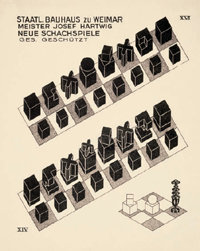Donation Dora Hartwig
dal 4/12/2006 al 4/12/2007
Segnalato da
4/12/2006
Donation Dora Hartwig
Bauhaus-Archiv, Berlin
The donation includes the game table created by her father Josef Hartwig, as well as artworks from his private collection: rare prints by Klee, Schlemmer, Feininger, and Kandinsky, and an extensive group of works by Gerhard Marcks. The highlight of the exhibition is the legendary chess set: its functionalist forms conceived in 1923 and produced in several different versions at the Weimar Bauhaus, were a radical break from traditional chess figures.

Special Exhibition
Josef Hartwig was workshop master in charge of sculpture at the Bauhaus
in Weimar. In 2003 his daughter Dora Hartwig made the Bauhaus Archive a
generous gift of not only the chess table that her father designed for
his famous Bauhaus chess set but also a a large number of important
works of art that he had owned. They include extremely rare prints by
his Bauhaus colleagues Feininger, Kandinsky, Klee and Schlemmer along
with many drawings and a sculpture by Gerhard Marcks. An item of very
special importance is a copy of Max Beckmann's Apocalypse dedicated to
Josef Hartwig. Until he was dismissed in 1933, Beckmann taught with
Hartwig at the Frankfurt Art School. The book was produced in a very
small wartime print run in 1943. It contained hand-coloured litho
illustrations and escaped the attention of the Nazi censors.
The focus of the exhibition is Josef Hartwig's legendary functionalist
chess set, developed between 1922 and 1924 at the Bauhaus. The shape of
the chessmen was no longer based on historical models but defined solely
by their function in the game of chess. The aim was to make the rules of
the game easier to understand for everyone, including beginners. "The new
chess pieces," Hartwig wrote, "are made out of simple stereometric bodies
- the cube and the sphere. Singly or in combination, their shape indicates
how the piece moves on the board, and their volume indicates its value.
The pawn and the castle move parallel to the edge of the board as
expressed by the cube. The knight moves in an L-shaped rectangular pattern
and combines cubes at a right angle. The bishop moves diagonally in
relation to the edge of the board as a saltire cut out of a cube. The king
moves both at a right angle and diagonally, a small cube superimposed at a
45' angle on a larger one. The queen, the piece that can move most freely,
consists of a cube and an orb." The chess set was made in numerous
versions and materials. They are here seen for the first time together -
from the early one-offs to the low cost, mass-produced "consumer set".
Image: Joost Schmidt, 1924, Lithograph, Bauhaus-Archiv Berlin.
Press Preview: Tuesday, December 05, 2006, 11 AM
Bauhaus Archiv
Klingelhoferstrasse, 14 - Berlin



